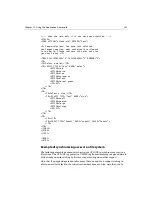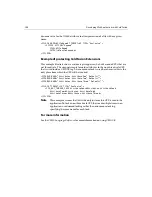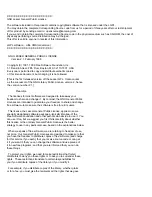
Chapter 12: Using the Application Framework
189
<!--- This example illustrates CFAPPLICATION --->
<!--- Name the application and enable client management--->
<CFAPPLICATION NAME="SearchApp"
4
CLIENTMANAGEMENT="Yes">
2.
Save the file as
Application.cfm
in the root directory of your application
framework.
Choosing a client variable storage method
Once you have enabled client state management, you then have to determine where
you want to store client variables. The system-wide default is for client variables to be
stored in the system registry. But your site administrator can choose to store them
instead in a SQL database or in cookies.
There are two steps to change client variable storage: first, setting a client variable
storage option in the Variables page of the ColdFusion Administrator, and then, noting
the client variable storage location in the CFAPPLICATION tag. See Administering
ColdFusion Server for information on using the ColdFusion Administrator.
You use the CLIENTSTORAGE attribute in the CFAPPLICATION tag to specify where
you want to store client variables, providing one of three values:
•
Registry
•
The name of a configured client store
•
Cookie
If no ClientStorage setting is specified, the default location, as noted in the ColdFusion
Administrator Variables page, is used.
The following example shows how you enable client state management using a sample
database called mydatasource.
To note the client variable storage method:
1.
Open the file
Application.cfm
in Studio and modify it so that it appears as
follows:
<!--- This example illustrates CFAPPLICATION --->
<!--- Name the application and enable client management--->
<CFAPPLICATION NAME="SearchApp"
CLIENTMANAGEMENT="Yes"
4
CLIENTSTORAGE="mydatasource">
2.
Save the file as
Application.cfm
in the root directory of your application
framework.
Note
Client storage mechanisms are exclusive; when one storage type is in use,
the values set in other storage options are unavailable.
Summary of Contents for COLDFUSION 4.5-DEVELOPING WEB
Page 1: ...Allaire Corporation Developing Web Applications with ColdFusion ColdFusion 4 5...
Page 14: ...xiv Developing Web Applications with ColdFusion...
Page 26: ...xxvi Developing Web Applications with ColdFusion...
Page 34: ...8 Developing Web Applications with ColdFusion...
Page 70: ...44 Developing Web Applications with ColdFusion...
Page 84: ...58 Developing Web Applications with ColdFusion...
Page 114: ...88 Developing Web Applications with ColdFusion...
Page 148: ...122 Developing Web Applications with ColdFusion...
Page 174: ...148 Developing Web Applications with ColdFusion...
Page 208: ...182 Developing Web Applications with ColdFusion...
Page 244: ...218 Developing Web Applications with ColdFusion...
Page 274: ...248 Developing Web Applications with ColdFusion...
Page 288: ...262 Developing Web Applications with ColdFusion...
Page 300: ...274 Developing Web Applications with ColdFusion...
Page 350: ...324 Developing Web Applications with ColdFusion...
Page 362: ...336 Developing Web Applications with ColdFusion...
















































